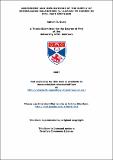Files in this item
Assessment and implications of the supply of Semibalanus balanoides (L.) larvae to shores in Fife, East Scotland
Item metadata
| dc.contributor.advisor | Todd, Christopher David | |
| dc.contributor.author | Gude, Adrian R | |
| dc.coverage.spatial | 231 | en |
| dc.date.accessioned | 2007-02-14T12:21:05Z | |
| dc.date.available | 2007-02-14T12:21:05Z | |
| dc.date.issued | 2007-01-19 | |
| dc.identifier | uk.bl.ethos.551971 | |
| dc.identifier.uri | https://hdl.handle.net/10023/164 | |
| dc.description.abstract | Investigations into the supply, settlement and recruitment of the barnacle Semibalanus balanoides (L.) to shores in Fife, East Scotland were undertaken over three consecutive years (2004 – 2006). Several designs of a passive larval trap, based on earlier published designs, were employed to quantify the delivery (supply) of cyprids to the substratum. Pump samples from the water column were collected to provide a measure of intertidal cyprid concentration. Cyprid concentration was found to exhibit both spatial and temporal variation, but was also found to be significantly correlated with cyprid supply, as quantified by the traps. In some years, pump and trap samples suggested that cyprid abundance in the intertidal was mediated by wind-driven processes. An artificial substratum was used to quantify cyprid settlement, allowing investigations into the supply-settlement relationship. Supply and settlement were found to be two very distinct biological phases. Supply describes the flux of larvae to the substratum. Settlement provides a measure of the amount of larvae that decide to settle on the substratum, as initial attachment for barnacle larvae is not permanent. Whilst supply saturation is unfeasible, daily saturation of the substratum by settlers was observed at many sites along the Fife coast. Levels of settlement saturation were found to vary both temporally, between years, and spatially, over scales of km. Varying levels of the desperation of larvae to settle, mediated by dwindling energy reserves, was thought to explain some of this variation. The supply data also provided some evidence of the possible movement of cyprids along the Fife coast from Fife Ness to Tentsmuir. However, wind-induced transport may also play a dominant role on the Fife coast. A comparison of supply and recruitment of larvae into adult populations revealed that both pre- and post-settlement events may influence recruitment. The relative importance of these factors was shown to be density-dependent. Negative intraspecific interactions were only seen in denser aggregations of adults. In less crowded aggregations, recruitment reflected initial patterns of larval supply. | en |
| dc.format.extent | 2922366 bytes | |
| dc.format.mimetype | application/pdf | |
| dc.language.iso | en | en |
| dc.publisher | University of St Andrews | |
| dc.rights | Creative Commons Attribution 2.5 Generic | |
| dc.rights.uri | http://creativecommons.org/licenses/by/2.5/ | |
| dc.subject | Barnacle | en |
| dc.subject | Supply | en |
| dc.subject | Settlement | en |
| dc.subject | Recruitment | en |
| dc.subject.lcc | QL444.C58G7 | |
| dc.subject.lcsh | Barnacles--Scotland--East Fife | en |
| dc.subject.lcsh | Barnacles--Larvae--Geographical distribution | en |
| dc.title | Assessment and implications of the supply of Semibalanus balanoides (L.) larvae to shores in Fife, East Scotland | en |
| dc.type | Thesis | en |
| dc.type.qualificationlevel | Doctoral | en |
| dc.type.qualificationname | PhD Doctor of Philosophy | en |
| dc.publisher.institution | The University of St Andrews | en |
This item appears in the following Collection(s)
Except where otherwise noted within the work, this item's licence for re-use is described as Creative Commons Attribution 2.5 Generic
Items in the St Andrews Research Repository are protected by copyright, with all rights reserved, unless otherwise indicated.


